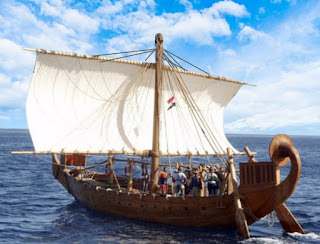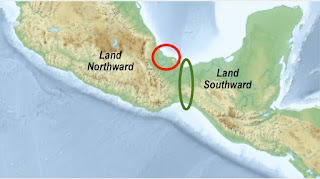Response: According to Thomas B. Marsh, who was then the President of the Quorum of the Twelve, as told by a Brother Higginson at a meeting in Spanish Fork, in the winter of 1896, Marsh claimed that the Prophet Joseph Smith told him that he became very anxious to know something of the fate of Moroni, and in answer to prayer the Lord gave Joseph a vision.
Moroni in a wild country where he kept. hidden for a good length of time before being spotted by six Lamanites
As to when this death occurred, that is unknown other than it would have been sometime after 421 A.D., which was 35 or 36 years after the final battle at Cumorah. As an example, we do not know what happened to the 24 survivors (Mormon 6:11) of that first wave of battle, among whom was Mormon. It is thought that Mormon and the others, except for Moroni until years later, were among those that were tracked down by the Lamanites and killed that Moroni mentioned (Mormon 8:2), but again, we simply do not know.
This is the only account we have ever run across, and since it was handed down through three or four people, and we take it only as a possibility. The author of the book died in 1994, and there is no way to verify where he got the story from or how authentic it is.
Comment #2: “I believe this country, and the Smith family, was prepared to be in the right place to find where the plates were buried. I don't know all the answers, but I believe the plates were found right where Mormon buried them” Carson J.
Response: Evidently, the plates Mormon hid up in the earth, i.e., those not handed over to his son, Moroni, have never been obtained. Mormon 6:6 tells us that Mormon made a complete abridgement of the Large Plates of Nephi (from Lehi through 4th Nephi) and gave them to his son, Moroni (see also Words of Mormon 1:1). He buried all the other plates (Brass Plates, Plates of Ether, and likely all the records kept by the Nephites (Helaman 3:13,15).
He did not want these plates that had been passed down to him to be destroyed. No doubt Moroni was instructed the same thing by his father, Mormon.
Joseph Smith after reeceiving the plates from Moroni
Comment #3: “I read where John Clark of BYU said, ‘The cultural worlds of ancient Mesoamerica and early New York are far enough apart that it ought to be simple to discover from which one the book came. The cultures described in the Book of Mormon fit much better in Mesoamerica than in New York for any century.’ I figured you might have an opinion and I'd appreciate knowing what it is” Kenneth W.
Response: Actually, there isn’t a whole lot to say about this. Clark believes in Mesoamerica, others believe in the Great Lakes or Heartland of the U.S. But it really doesn’t matter what people believe in, it only matters what the scriptural record says by those who sailed there, lived and fought and died there, who knew the land and its location better than any modern professor historian or scholar, and what they have written and the descriptions they left us are quite clear and not open to individual interpretation as no scripture is.
Nephi told us how he
sailed by winds and currents being “driven forth before the wind.” There are no
two ways to interpret this—winds and currents are very clear, have always been
the same, and lead in only one direction for a ship “driven before the wind,”
i.e., meaning it was pushed forward, not drawn forward through tacking, but
pushed forward where the winds blew it. Follow that track and it takes you to
where Lehi landed, where Nephi traveled and founded the City of Nephi and where
the Nephite nation flourished for 1000 years.
Comment #3: “John Sorenson insists that the final battle of the Nephites took place near the narrow neck of land. Is that correct? I thought it took place in the Land Northward “so far northward” that it came into the Land of Many Waters where the Jaredites had been destroyed” Brighton C.
Response: You are
right. Sorenson has placed his hill Cumorah close to his narrow neck of land,
therefore he has to claim the battle took place near that narrow neck. In all
reality, the scriptural record tells us that the Land of Many Waters, Rivers
and Fountains was far to the north, which also contained the Land of Cumorah
and the hill Cumorah. Sorenson has his hill almost on the east coast, but the
scriptural record tells us it was located to the west of the city and land of
Ablom, which was west of the coast or east sea.
Comment #4: “So what is your conclusion about Zelph? My conclusion is that the early brethren jumped to a bunch of conclusions creating a mass of confusion on the matter. Since we don't know what Joseph said on the subject I think the entire episode needs to be dismissed. Doesn't ring true since we know where the Lamanite and Nephites really lived. What is your conclusion?” Terry
Response: Our opinion, for whatever it is worth, is that, like any event in history as well as today, when you have several witnesses writing or speaking about an event all saw, you have vastly different responses or reports. Ask any policeman about the various ways a single event is described by several witnesses. As for the event itself, I believe it took place more or less as it was reported; however, each surrounded their writing of it based on their own views and opinions of the location and how they described it, i.e., from Cumorah to the Rocky Mountains; from the Sea East to the Rocky Mountains; from the sea to the Rocky Mountains; a White Lamanite; a Nephite; the last battle between the Nephites and Lamanites; the last battle; Joseph Smith was present when the bones were found; Joseph was not present; Joseph joined them later and discussed it; etc.
As for knowing where the Nephites and
Lamanites were, yes, the account recorded in the Book of Mormon on the plates
took place in what we call the Land of Promise, which we reference to the
western portion of South America; on the other hand Hagoth’s ships took numerous
people to “a land which was northward,” which would have been into Central and
Meso-America where similar ruins and cultures have been found--the only ones
found anywhere in the Western Hemisphere. From there remnants would have
traveled into Mexico, what is now the U.S. and possibly southern Canada. We are
talking about a Nephite history of a thousand years, Hagoth’s immigrants for
about 1500 years, and much or all of the Western Hemisphere could have been
covered in that time since we see how in the scriptural record the Nephites in
the small area of the recorded Land of promise kept spreading across the land
from sea to sea (Helaman 3:8).
Comment #3: “John Sorenson insists that the final battle of the Nephites took place near the narrow neck of land. Is that correct? I thought it took place in the Land Northward “so far northward” that it came into the Land of Many Waters where the Jaredites had been destroyed” Brighton C.
Red Circle: Sorenson’s Hill Cumorah; Green
Arrow: Sorenson’s Narrow Neck of Land
Comment #4: “So what is your conclusion about Zelph? My conclusion is that the early brethren jumped to a bunch of conclusions creating a mass of confusion on the matter. Since we don't know what Joseph said on the subject I think the entire episode needs to be dismissed. Doesn't ring true since we know where the Lamanite and Nephites really lived. What is your conclusion?” Terry
Response: Our opinion, for whatever it is worth, is that, like any event in history as well as today, when you have several witnesses writing or speaking about an event all saw, you have vastly different responses or reports. Ask any policeman about the various ways a single event is described by several witnesses. As for the event itself, I believe it took place more or less as it was reported; however, each surrounded their writing of it based on their own views and opinions of the location and how they described it, i.e., from Cumorah to the Rocky Mountains; from the Sea East to the Rocky Mountains; from the sea to the Rocky Mountains; a White Lamanite; a Nephite; the last battle between the Nephites and Lamanites; the last battle; Joseph Smith was present when the bones were found; Joseph was not present; Joseph joined them later and discussed it; etc.
The Zelph
Mound referred to as the Naples-Russell Mound #8, Pike County, Illinois
The Lord does not hide what he does, but it is not always clear what is to man’s limited view the Plan of God. The more we study things out in our own mind, the more we can know and understand what some call the mysteries of God.









No comments:
Post a Comment